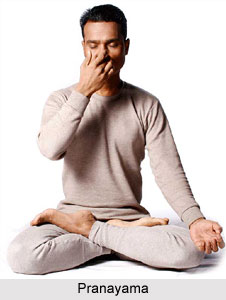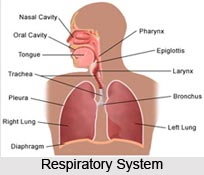 Over the years, the experts of Pranayama have carried on several discussions on the Respiration of Pranayama. It is needless to say, that even a layman who is not at all aware of various aspects of Pranayama is aware of the fact that Pranayama has much to do with inhaling and exhaling air. In other words, respiration techniques form an integral part of any Pranayamic study. While respiring, a human being alternately expands and also contracts chest. Due to this, air is taken into the lungs and also gets expelled from there. Thus the organs of respiration may be counted as, the nose, the larynx the pharynx, the trachea, the bronchi and the lungs. Nerves and numerous blood vessels linked with these parts of the human body may also be seen upon as the organs of respiration.
Over the years, the experts of Pranayama have carried on several discussions on the Respiration of Pranayama. It is needless to say, that even a layman who is not at all aware of various aspects of Pranayama is aware of the fact that Pranayama has much to do with inhaling and exhaling air. In other words, respiration techniques form an integral part of any Pranayamic study. While respiring, a human being alternately expands and also contracts chest. Due to this, air is taken into the lungs and also gets expelled from there. Thus the organs of respiration may be counted as, the nose, the larynx the pharynx, the trachea, the bronchi and the lungs. Nerves and numerous blood vessels linked with these parts of the human body may also be seen upon as the organs of respiration.
Needless to say, if one wants to gather some information about the respiration in Pranayama, functioning of theses respiratory organs become absolutely necessary. During the process of respiration in Pranayama, human nose is mostly used for inhaling and exhaling air. The holes of nose from where the air passes on are called nostrils. The skin that lines both these nostrils is surrounded with small hairs, better known as cilia. Just like any filter, this cilia is used to catch dust particles and also other tiny particles that gets mixed up with the air one inhales. Usually, mouth is used mainly for breathing in air in large amount than what can be puffed in via the nostrils. Pharynx and Larynx are other organs utilized during respiration in Pranayama; the pharynx is the opening, located just behind the mouth and nose.
Since these form both respiration and digestion, air that one breathes in during respiration in Pranayama, gets mingled up with food particles. Naturally, both food and air pass through the pharynx. Pharynx is covered up with tissues, namely tonsils that can create partial obstruction during passage of air. The pharynx ends in esophagus, the passage way created between the pharynx and the stomach. The larynx is also known as the "voice box" since it houses the vocal chords and the different muscles. These chords and muscles are used in producing sounds mainly during respiration in Pranayama.
 A cartilage can be located at the crest of the larynx. It is rightly epiglottis and it helps in closing the larynx organ tightly to prevent the passage of food or liquids. It is quite effective during respiratory process.
A cartilage can be located at the crest of the larynx. It is rightly epiglottis and it helps in closing the larynx organ tightly to prevent the passage of food or liquids. It is quite effective during respiratory process.
The trachea, the significant organ for respiration in Pranayama is widely referred as the windpipe. It is significant because through this tube respiratory gas gets transmitted. It is also covered with ciliated cells for pushing out dust particles. A special cartilage rings are found for guarding it against pressure while breathing air. The end of the trachea gets splitted up into two tubes, better known as the bronchi. The bronchi also have various `thin-walled branches` called bronchioles. These bronchioles actually lead to air sacs, namely, alveoli. Here in these air sacs, raid exchange of gases occurs during the respiration in Pranayama.
Amongst the organs of human body that are widely used for respiration in Pranayama, the lungs are the most important. They comprise of a bunch of alveoli and bronchioles, blood vessels and capillaries. Flexible tissues are also been found. Their chief function is to transmit oxygen into the blood. Its other function that is quite effective during respiration in Pranayama is the excretion of toxic carbon dioxide into the air outside.
The thorax consists of that part of human that gets extended from the neck to the back of a human body. It also plays a vital role during respiration in Pranayama.




















